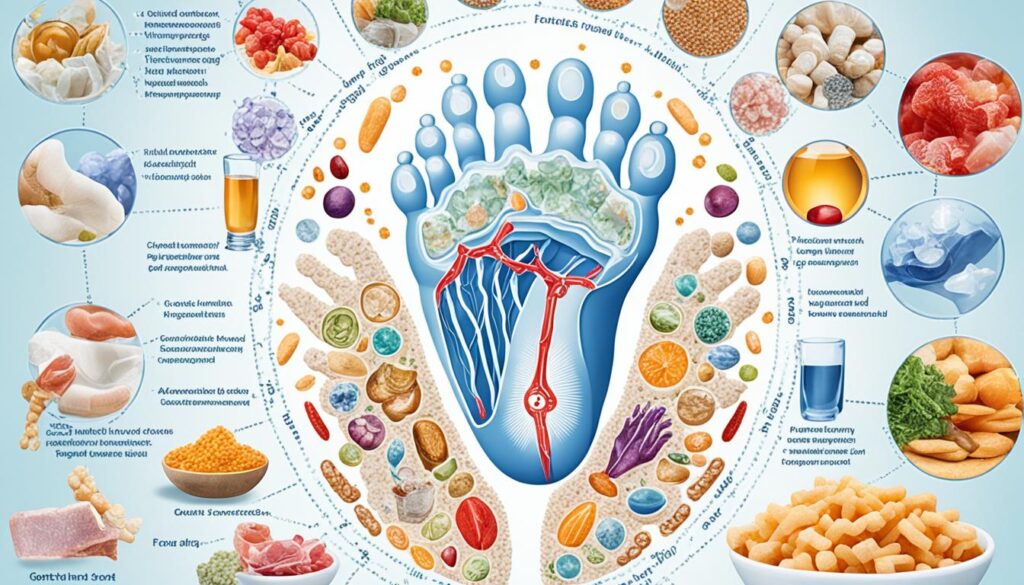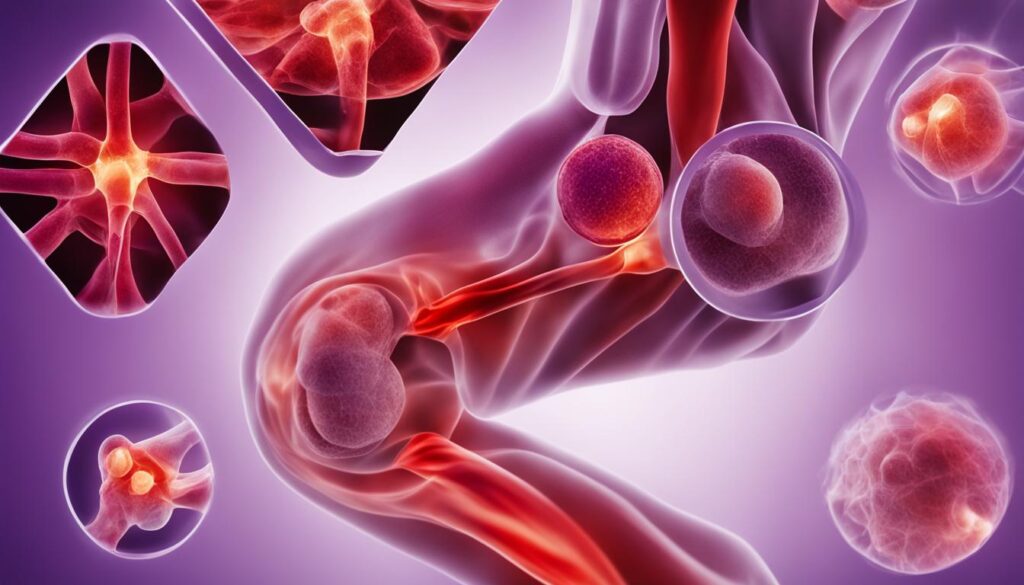REASONS of Gout
Have you ever experienced sudden, excruciating pain in your joints, particularly in your big toe? If so, you may be familiar with gout, a form of arthritis that affects millions of people worldwide. But do you know what causes gout and the key factors that contribute to its development?
Gout is not just a result of a poor diet or excessive alcohol consumption; there are various reasons why it occurs. By understanding these reasons and risk factors, you can take proactive steps to manage and prevent gout flares.
In this article, we will explore the key factors behind gout, including the causes, risk factors, and symptoms. We will explore how diet, genetics, and underlying health conditions play a crucial role in the development of gout. Additionally, we will discuss the complications that can arise if gout is left untreated and the diagnosis and treatment options available.
If you want to gain a comprehensive understanding of gout, its causes, and effective management strategies, keep reading to discover the insights you need to take control of your health.
Key Takeaways:
- Gout is a common form of arthritis characterized by sudden and severe attacks of joint pain.
- The accumulation of urate crystals in the joints due to high levels of uric acid in the blood is the main cause of gout.
- Factors contributing to the development of gout include diet, genetic predispositions, and underlying health conditions.
- Gout can be managed through lifestyle modifications, medication, and proper self-care strategies.
- Understanding the reasons behind gout is crucial for effectively managing the condition and preventing flares.
Symptoms of Gout
Gout is characterized by a range of symptoms that can significantly impact daily life. The most common symptom is intense joint pain, typically in the big toe. However, gout can also affect other joints, including the ankles, knees, elbows, wrists, and fingers. The pain is often described as sharp, sudden, and excruciating.
Aside from joint pain, gout can also cause swelling, redness, and tenderness in the affected area. These symptoms can make it difficult to walk or perform simple tasks. Gout flares can vary in duration, with some lasting a few days and others lingering for weeks.
Gout flares can be triggered by various factors, including:
- Diet: Consuming foods high in purines, such as red meat, seafood, and alcohol, can trigger gout attacks.
- Alcohol consumption: Drinking excessive amounts of alcohol, particularly beer, has been linked to an increased risk of gout flares.
- Medications: Certain medications, such as diuretics and aspirin, can raise uric acid levels in the blood, increasing the likelihood of gout development.
- Recent surgery or trauma: Gout attacks can be triggered by physical trauma or surgical procedures.
- Certain medical conditions: Existing health conditions like high blood pressure, obesity, diabetes, and kidney disease can contribute to gout development.
The pain and inflammation associated with gout can severely limit joint mobility and disrupt daily activities. If left untreated or unmanaged, gout can lead to complications that further impact the quality of life.
Risk Factors for Gout
Several factors can increase the risk of developing gout. Understanding these risk factors is crucial for prevention and management. Here are the key factors for gout development:
Diet :
A diet high in purine-rich foods like red meat and seafood can contribute to elevated uric acid levels in the blood, increasing the risk of gout. Limiting the consumption of these foods can help reduce the risk.
Alcohol consumption:
Excessive alcohol consumption, particularly beer and spirits, has been associated with an increased risk of gout. Limiting alcohol intake or avoiding it altogether can help lower the risk.
Weight :
Being overweight or obese is a significant risk factor for gout. Excess weight contributes to higher levels of uric acid in the blood. Losing weight through a combination of healthy eating and regular exercise can help reduce the risk.
Medical conditions:
Having certain medical conditions, such as high blood pressure, diabetes, and kidney disease, can increase the risk of developing gout. Proper management of these conditions is essential to minimize the risk of gout.
Medications :
Some medications, including diuretics (water pills) and aspirin (in high doses), can raise uric acid levels and increase the likelihood of gout. It is important to discuss all medications with a healthcare professional to assess their potential impact on gout risk.
Family History
A family history of gout increases the likelihood of developing the condition. Genetic factors can play a role in determining an individual’s susceptibility to gout, making it important to be aware of any family history.
Gender :
Men are more prone to developing gout than women. However, women’s risk of gout increases after menopause due to hormonal changes. It is vital for both men and women to understand their individual risk factors and take appropriate steps for prevention.
By understanding the risk factors associated with gout, individuals can make informed choices and take proactive measures to reduce their risk. It is essential to consult with a healthcare professional for personalized guidance and comprehensive management strategies.
Causes of Gout:
Gout is primarily caused by an imbalance of uric acid in the body. Uric acid is produced when the body breaks down purines, which are naturally present in the body and certain foods. However, several factors contribute to the development of gout.
Excessive Production of Uric Acid: The overproduction of uric acid can occur due to genetic factors or lifestyle choices. Consuming purine-rich foods such as organ meats, seafood, and alcoholic beverages can increase uric acid production in the body.
Decreased Excretion by the Kidneys: The kidneys play a vital role in removing uric acid from the body. However, if the kidneys fail to excrete an adequate amount of uric acid, it can lead to its accumulation and the formation of urate crystals.
Formation of Urate Crystals: When there is an excess of uric acid in the blood, it can crystallize and deposit in the joints, leading to inflammation and gout flares. Factors such as high levels of uric acid, acidic pH levels, and temperature changes in the joints can contribute to the formation of urate crystals.
Dietary Factors: Certain dietary choices can play a significant role in gout development. Consuming purine-rich foods like red meat, organ meats, seafood, and fructose-sweetened drinks can increase uric acid levels in the body, contributing to the formation of urate crystals.
Genetics: Some individuals may have a genetic predisposition to gout. Genetic factors can influence the body’s production and excretion of uric acid, making it more susceptible to developing the condition.
Age and medical conditions: Gout is more common in men and usually develops after the age of 30. However, women’s risk increases after menopause. Additionally, certain medical conditions, such as obesity, high blood pressure, diabetes, and kidney disease, can contribute to gout development.

In summary, the causes of gout involve an interplay of factors such as excessive uric acid production, decreased excretion by the kidneys, the formation of urate crystals, dietary choices, genetics, age, and certain underlying medical conditions. Understanding these causative factors can help individuals make informed lifestyle choices and seek appropriate medical management to prevent, manage, and reduce the frequency of gout flares.
Complications of Gout:
If left untreated or poorly managed, gout can lead to various complications that can significantly impact a person’s health and quality of life. Proper gout prevention, management, and addressing underlying conditions are essential to minimizing these complications.
Recurrent Gout Attacks:
Gout is characterized by sudden and intense joint pain, commonly in the big toe but can also affect other joints like the ankles, knees, wrists, and fingers. If gout flares are not effectively prevented or managed, they can recur frequently, causing recurring pain and inflammation.
Joint Damage:
Untreated or poorly managed gout attacks can progressively damage the joints. The prolonged presence of urate crystals in the joints can lead to joint erosion, stiffness, and limited mobility. Over time, this can significantly impact a person’s ability to perform daily activities and reduce their overall quality of life.
The Formation of Tophi:
Tophi are accumulations of urate crystals that form under the skin in areas affected by gout. They appear as lumps or nodules and can cause pain, deformity, and disfigurement. Tophi are more likely to develop in people with uncontrolled gout and can lead to further joint damage and complications.

Kidney stones:
Gout can also contribute to the formation of kidney stones, which are hard deposits of minerals and salts that form in the kidneys. Uric acid stones are particularly common in people with gout and can cause severe pain, urinary tract infections, and other complications related to kidney function.
Reducing the Risk of Complications
To reduce the risk of complications associated with gout, it is crucial to focus on gout prevention and proper management. This involves making lifestyle changes, managing underlying health conditions, and adhering to prescribed medications.
| Gout Complications | Prevention and Management |
|---|---|
| Recurrent gout attacks |
|
| Joint damage |
|
| The formation of tophi |
|
| Kidney stones |
|
Proper management of gout, including lifestyle changes and adherence to treatment plans, can significantly reduce the risk of complications and improve the overall quality of life for individuals living with this condition.
Diagnosis and Treatment of Gout:
Diagnosing gout involves a comprehensive approach that includes assessing symptoms, conducting a physical examination, and utilizing medical imaging and lab tests. These diagnostic measures aim to pinpoint the presence of uric acid crystals in the affected joint, confirming the diagnosis of gout.
During a physical examination, a healthcare professional will evaluate the affected joint for signs of inflammation, redness, warmth, and tenderness. Additionally, they may order X-rays to examine the joint for the presence of urate crystals or to rule out other underlying conditions that may mimic the symptoms of gout.
Lab tests play a crucial role in the diagnosis of gout. Blood tests can measure the levels of uric acid in the blood, helping to confirm the presence of hyperuricemia. However, it’s important to note that an elevated uric acid level alone does not confirm a diagnosis of gout, as some individuals with high levels may not develop the condition, while others with normal levels may still experience gout attacks.
A more accurate method of diagnosis is joint fluid aspiration, also known as arthrocentesis. During this procedure, a needle is used to withdraw a small sample of fluid from the joint, which is then examined under a microscope to detect the presence of urate crystals. The identification of urate crystals in the joint fluid is highly indicative of gout.

Once a diagnosis of gout is confirmed, treatment primarily focuses on relieving pain during acute flares, preventing future flares, and reducing the risk of complications. Nonsteroidal anti-inflammatory drugs (NSAIDs) are commonly prescribed to manage pain and inflammation during gout attacks. Colchicine, another medication, can also be effective in mitigating the symptoms of acute gout.
In addition to pain management, lifestyle modifications are crucial in preventing future gout flares. This includes adopting a healthy diet that is low in purine-rich foods, such as red meat and seafood, and limiting alcohol consumption, as alcohol can contribute to increased uric acid levels. Maintaining a healthy weight and engaging in regular physical activity can also have a positive impact on gout management.
Medications that lower uric acid levels may be prescribed to reduce the frequency and severity of gout attacks. These medications work by either limiting uric acid production or increasing its excretion from the body. Commonly prescribed medications for long-term management include xanthine oxidase inhibitors (e.g., allopurinol) and uricosuric drugs (e.g., probenecid).
Gout Treatment Overview:
| Treatment Approach | Description |
|---|---|
| Medication for pain relief | Nonsteroidal anti-inflammatory drugs (NSAIDs) or colchicine can be prescribed to manage pain and inflammation during acute gout flares. |
| Lifestyle modifications | Adopting a low-purine diet, limiting alcohol consumption, maintaining a healthy weight, and engaging in regular physical activity are key to preventing future gout flares. |
| Medications to lower uric acid levels | Long-term management of gout often involves medications that reduce uric acid production or increase its excretion from the body. |
By combining medical treatment and self-management strategies, individuals with gout can effectively control their symptoms, prevent future flares, and reduce the risk of complications. It’s important for individuals diagnosed with gout to work closely with their healthcare providers to develop a personalized treatment plan that suits their specific needs.
Who gets gout?
Gout is a condition that can affect anyone, but certain demographics and risk groups have a higher prevalence. Understanding the different risk factors and demographics associated with gout can help in better managing and preventing the condition.
In the United States, gout prevalence is higher among men compared to women. Men are more likely to develop gout, especially between the ages of 30 and 50. However, women’s risk of gout increases after menopause.
Aside from gender and age, other risk groups for gout include individuals with a family history of gout. Having a close relative with gout increases the likelihood of developing the condition. Additionally, being overweight or obese can also increase the risk of gout.
People with underlying health conditions such as high blood pressure, diabetes, and kidney disease are also more prone to gout. These conditions can contribute to higher uric acid levels in the body, increasing the risk of crystal formation and gout development.
It’s essential for individuals in these risk groups to be mindful of their lifestyle choices, manage their overall health, and work closely with healthcare providers to prevent and manage gout effectively.
| Risk Factors for Gout | Demographics |
|---|---|
| Family history of gout | Men (especially ages 30–50) |
| Overweight or obesity | Women (after menopause) |
| High blood pressure | |
| Diabetes | |
| Kidney disease |
Managing Gout and Improving Quality of Life
Managing gout involves a combination of medical treatment and self-management strategies. By making lifestyle changes and working closely with healthcare providers, individuals with gout can effectively manage their condition and improve their quality of life.
One of the key aspects of gout self-management is adopting a healthy diet. A diet low in purine-rich foods can help reduce the production of uric acid in the body, minimizing the risk of gout flares. It is recommended to limit the consumption of red meat, seafood, and organ meats, which are high in purines. Instead, focus on incorporating more fruits, vegetables, whole grains, and lean proteins into your diet.
Alcohol consumption is another important aspect to consider. Alcohol can increase the levels of uric acid in the body and trigger gout flares. It is advisable to limit or avoid alcohol, especially beer and liquor, which have been associated with a higher risk of gout.
Maintaining a healthy weight is crucial for managing gout and reducing the frequency of flares. Excess weight puts additional stress on the joints, increasing the risk of gout attacks. Regular physical activity can help control weight, improve joint flexibility, and lower uric acid levels. Include activities such as walking, swimming, or cycling in your daily routine to stay active.
In addition to lifestyle changes, monitoring and managing underlying health conditions that can contribute to gout is essential. High blood pressure, diabetes, and kidney disease are often associated with gout. Working with healthcare providers to control these conditions can help prevent gout flares and improve overall health.
“Managing gout involves a holistic approach that combines medical intervention with lifestyle modifications. By following a nutritious diet, maintaining a healthy weight, and effectively managing other health conditions, individuals can take control of their gout and significantly enhance their quality of life.”
Regular follow-up appointments with healthcare providers are crucial for managing gout. They can monitor uric acid levels, adjust medications if necessary, and provide guidance on lifestyle changes. Open communication and active participation in your own healthcare journey are keys to successful self-management.
Prevention Steps
To prevent gout flares and improve quality of life:
- Follow a low-purine diet
- Avoid or limit alcohol consumption
- Maintain a healthy weight
- Stay physically active
- Monitor and manage underlying health conditions
- Attend regular check-ups with healthcare providers
Taking these steps can help individuals effectively manage their gout and minimize its impact on their overall quality of life. With dedication to self-care and the support of healthcare professionals, individuals with gout can lead fulfilling and pain-free lives.
Gout Lifestyle Changes Table
| Lifestyle Changes | Benefits |
|---|---|
| Following a low-purine diet | Reduces uric acid production and the frequency of gout flares |
| Limiting alcohol consumption | It helps lower uric acid levels and prevents gout triggers |
| Maintaining a healthy weight | Reduces stress on joints and lowers the risk of gout attacks |
| Staying physically active | Improves joint flexibility and overall health |
| Monitoring and managing underlying health conditions | It prevents complications and reduces gout flares |
Gout is a complex form of arthritis that can cause significant pain and discomfort. It is important to have a thorough understanding of the reasons and factors contributing to gout in order to effectively manage and prevent flare-ups. By addressing dietary triggers, genetic predispositions, and underlying health conditions, individuals can take proactive steps to reduce the frequency and severity of gout attacks and improve their overall quality of life.
Working closely with healthcare providers is essential to developing a comprehensive treatment plan that includes both lifestyle modifications and appropriate medications. By making necessary changes in diet, managing weight, and adopting a healthier lifestyle, individuals can enhance their gout management and minimize the impact of this condition on their daily lives.
To achieve optimal results, it is crucial to stay consistent with prescribed treatments and regularly monitor and manage underlying health conditions that may contribute to gout. By taking a proactive approach, individuals can maintain better control over their gout and experience improved quality of life. Remember, in the journey to manage gout, healthcare providers are invaluable partners who provide guidance and support every step of the way.
FAQ
What are the reasons for gout and key factors?
What are the symptoms of gout?
What are the risk factors for gout?
What are the causes of gout?
What are the complications of gout?
How is gout diagnosed and treated?
Who is at risk of developing gout?
How can gout be managed and the quality of life improved?









